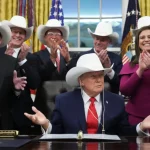

Automakers are bracing for months of uncertainty as they look to retool their electric vehicle investments in response to lower consumer demand, adjust for new battery sourcing requirements that exclude many of their models from federal subsidies, and prepare for a presidential election that could upend the industry.
Here are some of the biggest challenges facing automakers:
BIDEN STARING DOWN ‘FIVE-ALARM FIRE’ WITH MINORITY VOTERS. CAN HE WIN BACK SUPPORT?
New tax credit guidance
New battery production and sourcing requirements took effect for EV makers on Jan. 1, outlining which EVs qualify for the up-to-$7,500 consumer tax credit included in the Inflation Reduction Act, the 2022 legislation passed by Democrats with major clean energy provisions.
The guidance was published by Treasury last month and is intended to help reshore domestic supply chains and move EV battery production and manufacturing away from China.
But the rules more than halved the number of EV models eligible for the tax credit, reducing the number of qualifying vehicles from 43 to 19 and sending automakers scrambling to adjust their sales plans to make up for lost tax credits and keep costs lower for consumers.
General Motors announced on Wednesday that it would offer a $7,500 incentive to consumers for any of its vehicles that lost Inflation Reduction Act tax credit eligibility. GM’s Chevy Bolt is the only model that is eligible under the new criteria.
And Ford said on Wednesday it would increase the price of its F-150 Lightning EV, one of several of its vehicles eligible for the tax credit, by between $5,000 and $10,000 and lower prices for EVs that did not qualify for the subsidy.
Sluggish consumer demand
Automakers have invested billions in new domestic manufacturing and battery facilities in recent years and shifted investments away from gas-fired vehicles. But consumer enthusiasm has failed to catch up, at least for now, leaving automakers with factories and lots full of unsold EVs.
While EV sales have increased in the United States, making up at least 9% of all new passenger vehicles sold in 2023, sales still fall well below where companies and the Biden administration had hoped. The Biden administration has set a target for EVs to make up 50% of new car sales by 2030, which the Environmental Protection Agency’s proposed 2027-2032 vehicle emissions targets would sharpen further, targeting 60% by 2030 and 67% by 2032.
Some automakers have opted to trim their investments in EVs as they wait for consumer demand to catch up.
Ford announced in November it is scaling back a planned $3.5 billion investment in an EV battery plant in Marshall, Michigan, to align better with consumer demand. The automaker slashed its EV-related spending as a whole by $12 billion for the year and postponed construction of a planned battery factory in Kentucky.
“We’re still very bullish on EVs and our EV strategy, but clearly, while there is growth, both in the U.S. and worldwide, clearly the growth isn’t at the rate that we and others had expected,” Ford Chief Communications Officer Mark Truby told reporters in a call explaining the decision to pare back spending. “We’re trying to be smart about this and how we move forward.”
2024 elections
Automakers are also warily eyeing the 2024 presidential election, bracing especially for the impact of a Trump victory.
Former President Donald Trump, the GOP front-runner, has vowed repeatedly to tear up the Inflation Reduction Act if elected to a second term. He has focused especially on EVs as a way to attack President Joe Biden, claiming the administration’s EV push will “destroy” the U.S. auto industry and describing it as a “transition to hell.”
“You’re going to lose your beautiful way of life,” Trump said last fall. “For autoworkers, Biden’s forced transition is a transition to hell.”
Although undoing the Inflation Reduction Act would require an act of Congress, there are plenty of actions Trump could take as president that could deter new investments for EVs or add hurdles for automakers.
This could include ordering agencies to claw back the up-to-$7,500 EV tax credit provision for consumers, threatening automakers’ bottom lines and causing EV sales to fall even further in the U.S.
GM and Nissan outlined these concerns in a Financial Times interview this week, with Nissan CEO Makoto Uchida crediting the Inflation Reduction Act as crucial to helping increase U.S. EV sales “in the medium to long term.”
“We don’t want to end up saying this vehicle program is really good with the IRA, only to have the IRA go away, and now suddenly, the vehicle can’t make money,” GM Chief Financial Officer Paul Jacobson said of the tax credits.
Republican presidential candidates, especially Trump, see the industry’s growing pains as an area ripe for exploitation ahead of the 2024 election, Gary Clyde Hufbauer, a nonresident senior fellow at the Peterson Institute for International Economics, told the Washington Examiner this summer.
CLICK HERE TO READ MORE FROM THE WASHINGTON EXAMINER
Hufbauer said Trump can play on these tensions to gin up support with union employees under his “America-first” manufacturing push.
“That’s very much a card that Trump has played in the past, and there’s no reason why he can’t play it this time around,” he added.





